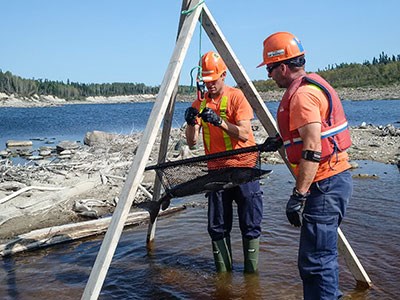For more than 25 years, Ontario Power Generation (OPG) has made it a priority to monitor the populations of lake sturgeon in its operating areas. And it’s starting to see some progress.
Though the OPG program has been in operation since 1991, work to help protect and recover the species began in earnest in 2008, after the lake sturgeon was listed on the province’s Endangered Species Act.
Dan Gibson, a senior environmental specialist with the OPG who oversees the lake sturgeon program, said when it comes to environmental management, it’s part of the company’s internal environment policy to meet or exceed provincial regulations.
“Obviously, we want to respect and honour the footprints that we’re working on and the landscapes that we’re working on,” Gibson said.
The OPG has registered mitigation plans around nine of its hydroelectric stations across the province; it identifies the risk to nearby lake sturgeon populations and puts in place measures to minimize the impacts of industrial activity on the species.
Lake sturgeon live in freshwater lakes and rivers and can live up to more than 100 years. But getting the population to flourish isn’t without its complications.
“It takes 20-plus years for a female to come to maturity,” Gibson said. “The females may only spawn every three to seven years, which adds a lot of complexity, but also a lot of resilience, to the population.”
A year of drought, for example, won’t be as devastating to lake sturgeon as in other populations. But when females do spawn, they drop hundreds of thousands of eggs into the lakebed.
The OPG’s mitigation programs vary across the province, but the main goal is to encourage natural reproduction.
In the Ottawa and St. Lawrence rivers, the OPG is constructing spawning shoals for fish, while in the Kaministiquia River, Nipigon River, and English and Winnipeg river systems, north of Kenora, the OPG is adjusting how it manages its operations.
In Timmins, in 2002, the organization transported 50 adult lake sturgeon a few hundred kilometres upstream to an area where the species had become extirpated and released them there. By 2011, anglers in the region were reporting catching small lake sturgeon.
“We went back out and looked and, lo and behold, we found a number of age classes spawning from those 50 fish that we had put in,” Gibson said. “So that’s a really positive story.”
The OPG is following up with a study to see what worked at that location so it can duplicate those efforts in other areas.
As part of its work constructing the Lower Mattagami River hydroelectric project, OPG has committed to monitoring the area — in particular, the lake sturgeon — for six years post-construction.
This October at the Mattagami, Gibson will to look for juvenile lake sturgeon to help predict the success of the programs.
“We’ll be setting up new nets, different style nets, different methodology to simply look for where the juvenile fish are located on the system,” he said. “The critical element to recovery is identifying the year classes of fish that are coming up in the system, so you can project what may be in 10 years’ time when all those year classes come to adulthood.”
Mitigation programs are re-evaluated every five years, and this most recent series of programs will come up for renewal in 2018, Gibson said.
But Gibson said there’s consensus among regulator scientists that sturgeon and dams can coexist, but OPG’s mandate goes beyond that, aiming to recover the threatened species.
“We want to go beyond simply coexisting,” Gibson said. “We want to encourage their recovery, and that recovery may be for the next 25, 30 years. It may be for the next 50 years until we start seeing those robust populations that we knew we had back in the early 1900s.”




